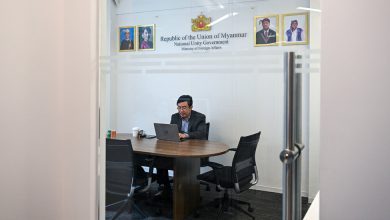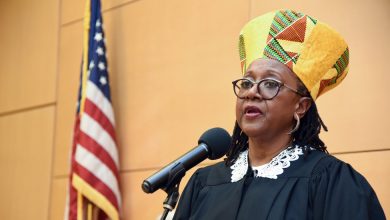Pope Apologizes in Canada for Schools That Abused Indigenous Children

MASKWACIS, Alberta — Pope Francis offered a sweeping apology directly to Indigenous people on their land in Canada on Monday, fulfilling a critical demand of many of the survivors of church-run residential schools that became gruesome centers of abuse, forced assimilation, cultural devastation and death for over a century.
“I humbly beg forgiveness for the evil committed by so many Christians against the Indigenous peoples,” Francis said to a large crowd made up largely of Indigenous people, some wearing traditional clothing and headdresses, in Alberta, near the site of a former residential school.
The pope delivered his message in a pow wow circle, a covered ring surrounding an open space used for traditional dancing and drumming circles. Around it were teepees, campfires and booths labeled “Mental Health and Cultural Support.”
Francis added that his remarks were intended for “every Native community and person” and said that a feeling of “shame” had lingered since he apologized to representatives of Indigenous people in April at the Vatican.
Before his speech, Francis visited a cemetery where local Indigenous people believe children were buried in unmarked graves.
He said he was “deeply sorry” — a remark that triggered applause and approving shouts — for the ways in which “many Christians supported the colonizing mentality of the powers that oppressed the Indigenous peoples.”
“I am sorry,” he continued. “I ask forgiveness, in particular, for the ways in which many members of the church and of religious communities cooperated, not least through their indifference, in projects of cultural destruction and forced assimilation promoted by the governments of that time, which culminated in the system of residential schools.”
The pope’s six-day visit to Canada, which will include a visit Tuesday to Lac Ste. Anne, a pilgrimage site that is sacred to many Indigenous people, and meetings with Indigenous and church representatives in Quebec City and the Arctic city of Iqaluit, came after years of pleas from Indigenous leaders and leading politicians for a Vatican apology for the abusive schools.
The school system was designed to erase Indigenous culture and language by forcibly separating children from their families and assimilating them into Western ways.
The Vatican apologies came years after formal apologies from the government of Canada, which established the system, and the Protestant churches that operated a smaller number of schools.
Physical, sexual and mental abuse were common at the schools, which banned Indigenous languages and cultural practices, often through violence. The use of Christianity as a weapon to break Indigenous people was spread across generations.
Christian churches ran most of the schools for the government, with Catholic orders responsible for 60 to 70 percent of the roughly 130 schools, which operated from the 1870s until 1996.
The apology on Monday, while a centerpiece of the trip, was also a jumping-off point for what the Vatican hopes will be a closer and more cooperative relationship, in which the church can become a force for reconciliation, rather than only grievance.
Francis, who suffers pain from knee trouble and sciatica and arrived at the event being pushed in a wheelchair, said it was “right to remember” what had happened at the site where such traumas took place, even at the risk of opening old wounds.
“It is necessary to remember how the policies of assimilation,’’ he said, “which also included the residential school system, were devastating for the people of these lands.” Francis added, “I thank you for making me appreciate this.”
He called the abuses, often carried out with missionary zeal, a “disastrous error” that eroded Indigenous people, their culture and values.
Francis also said that “begging pardon is not the end of the matter,” adding that he “fully” agreed with skeptics who want action. And he said that he hoped for further investigations and that “concrete ways” could be found to help survivors begin a path toward healing and reconciliation.
After delivering his speech, which he offered in Spanish and which was translated into English, Chief Wilton Littlechild of the Ermineskin Cree Nation, who had welcomed the pope, fitted him with a headdress, its white feathers standing over his white robes.
Until this year the Vatican had rebuffed repeated requests from Indigenous people for an apology. A National Truth and Reconciliation Commission established by the Canadian government declared the schools a form of “cultural genocide” and had called on the pope to make an apology in 2015.
Many Indigenous people attribute the Vatican’s shift to a shocking discovery announced just over a year ago at the former Kamloops Indian Residential School in the arid mountains of British Columbia’s interior.
An analysis of ground-penetrating radar scans found evidence, consistent with the testimony of former students, that hundreds of students had been buried in unmarked graves on school grounds. Subsequent radar searches produced similar grim evidence of remains at other schools in the following months.
After Francis finished his remarks, many who had gathered to listen said they were satisfied with what he had said.
“He clearly understands the evil of colonization,” said Phil Fontaine, the former national chief of the Assembly of First Nations, who, 32 years ago, was one of the first Indigenous leaders to publicly describe the abuse he suffered at Catholic-run residential schools. “I was touched by what I heard.”
But Mr. Fontaine, who sat near the pope on Monday, acknowledged that he and many other Indigenous people were disappointed by the pope’s failure to specifically address several issues. Among them are the church’s failure to make good on reparations to surviving students that it agreed to pay as part of the settlement of a landmark class-action lawsuit in 2006.
The Catholic Church has paid just 1.2 million of the 25 million Canadian dollars it had agreed to raise in cash contributions as compensation to survivors.
Still, Mr. Fontaine said the pontiff’s message was a significant step forward.
“He may not have said every word we wanted to hear,” Mr. Fontaine, who first sought an apology from Pope Benedict XVI during a Vatican meeting 13 years ago. “But he gave us an idea of the next steps.”
Hours after delivering his apology, Francis continued with what he has called his “penitential pilgrimage” by meeting more school survivors at the Sacred Heart Church of the First Peoples in Edmonton, Alberta’s capital.
“I can only imagine the effort it must take, for those who have suffered so greatly because of men and women who should have set an example of Christian living, even to think about reconciliation,” he told the former students.
Still, some Indigenous people, particularly younger people, were indifferent to the pope’s visit and apology.
“I’m very critical about the pope visit,” said Riley Yesno, 23, a doctoral student at the University of Toronto who is from Eabametoong First Nation in Ontario. “And I say that as somebody whose grandparents went to Catholic-run residential schools. I don’t see how any of these words that he’s going to say will actually fix the damage that the residential schools caused.”
After the pope spoke on Monday morning, Ms. Yesno said she was “taking a magnifying glass to the actual apology though I think there was a lot left to be desired.”
While the pope’s apology was preceded and followed by traditional Indigenous dancing, drumming and song, the pontiff was not involved in any traditional Indigenous spiritual ceremonies like smudging, the wafting of smoke created by burning cedar, sage, sweetgrass, and tobacco as a form of cleansing.
“Why did he not participate in our spiritual exercises?” Rachel Snow, a member of the Iyahe Nakoda Sioux First Nation in Morley, Alberta. “It should be a two-way street.”
But most people at Maskwacis welcomed the long-awaited papal apology.
“It was genuine and it was good,” said Cam Bird, 42, a residential school survivor from Little Red River Cree Nation in Saskatchewan. “He believes us.”
Some Indigenous people said they were still taking stock of the pope’s message and how it would resonate after so many generations of devastation and trauma.
“I haven’t really digested it yet,” said Barb Morin, 64, from Île-à-la-Crosse, Saskatchewan, who was wearing a T-shirt reading “Residential School Survivors Never Forgotten” and whose parents suffered at the institutions.
“I’m having a really hard time internalizing this right now.”
Jason Horowitz reported from Maskwacis, Alberta, and Ian Austen from Edmonton, Alberta.





